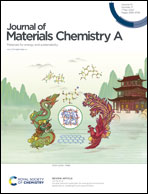Enhancing mechanism of electron-deficient p states on photocatalytic activity of g-C3N4 for CO2 reduction†
Abstract
By utilizing DFT calculations and AIMD simulations, we systematically investigated the photocatalytic activity of B/N2V-pg-C3N4, which is coplanar g-C3N4 with an electron-deficient B atom substituted for the nitrogen atom, for CO2 reduction. Significantly, electronic structure analysis revealed that compared with pristine pg-C3N4 (Eg = 2.98 eV), B/N2V-pg-C3N4 had a smaller band gap (Eg = 1.70 eV), where the position of the conduction band minimum (CBM) and valence band maximum (VBM) increased by approximately 0.79 eV and decreased by approximately 0.49 eV, respectively. Catalytic mechanism studies demonstrated that by comparison with the barrier of 1.55 eV in the hydrogen evolution reaction (HER), B/N2V-pg-C3N4 thermodynamically tended to catalyse CO2 into HCOOH (Ea = 0.86 eV) and HCHO (Ea = 0.86 eV) with high selectivity. Further, isotope effect calculations revealed that B/N2V-pg-C3N4 is an excellent catalyst for the synthesis of deuterium products using CO2. Thus, the activation of CO2 in B/N2V-pg-C3N4 is dictated by the curved geometry and its unique electronic-deficient p states, which are beneficial for its excellent photocatalytic performance for CO2 reduction.



 Please wait while we load your content...
Please wait while we load your content...